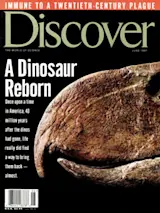Much of what makes us human can be traced to the cerebral cortex, a wrinkled sheet of gray tissue about an eighth of an inch deep that forms the outermost layer of the brain. It is the source of our language ability, home of our capacity to reason, and may be the seat of our consciousness. But how does the human brain become so convoluted, while those of many other mammals are perfectly smooth? What dictates where and how the cortex folds? David Van Essen, a neuroscientist at Washington University in St. Louis, offers a simple explanation. A tug-of-war among developing nerve cells, he says, pulls the brain into shape.
Without its convolutions, the cortex would take up three times the area it does in its wrinkled state. For something with the surface area of a very large pizza to fit inside the skull, it has to crumple up, says ...














